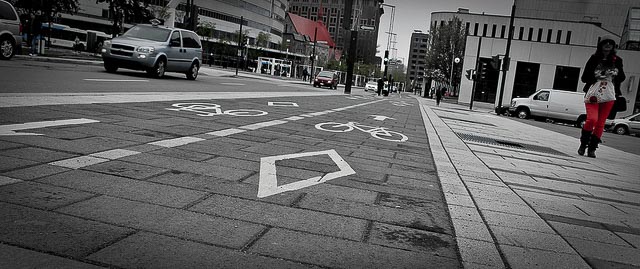Most of us don’t start our day thinking about potentially getting hurt in our travel. But that’s not the case for many bicyclists and pedestrians who joined the Kinder Institute’s “near-miss” study.
The study collected information on volunteers’ travel during one week in March, including their origins and destinations, travel mode and detailed accounts of near-misses and close calls on the road in which they narrowly avoided collisions.
A glimpse into a week of those close calls – like making a sudden stop or jumping out of the way to avoid collisions – shows how they are often a reoccurring experience. Out of 187 people who recorded their trips within the week, about one-third reported 133 near-miss incidents they experienced or witnesses.
Many of these near-miss incidents were attributed to a lack of awareness by other road users (usually, those traveling at faster speeds). Participants illustrate how either as pedestrians or bicyclists, they actively anticipate near-misses in their trips and try to avoid them by wearing brightly colored clothing or closely watching actions of those traveling at faster speeds (usually automobile drivers).
The study also offers insight on how some near-misses lead to subsequent physical intimidation and verbal attacks on pedestrians and bicyclists. That’s troublesome: In some cases, the tension that exists between the different road users could have fatal consequences.
Participants in the Kinder Institute study reported being targets of yelling, tailgating, and dangerous overtaking by motorists.
One of our participants, a bicyclist, reported that an automobile driver refused to pass her; instead, the driver yelled and urged her to "stay off the road" and use the sidewalk, which is considered unsafe. A pedestrian, crossing the street with a green walk signal, was reportedly told by an automobile driver to "get a job." A female bicyclist reported that a car swerved in front of her to block her path. The driver called her a "dumb bitch" and expressed his desire to see her struck by a car.
When a driver yells at, threatens, or assaults bicyclists and pedestrians, the actions highlight the contradiction between the law – which protects the right of bicyclists and pedestrians to use the road – and the longstanding notion that roads are built exclusively for automobiles.
That tension is important. Houstonians may want to live in more walkable communities, but even in some of these neighborhoods, near-miss experiences and harassments could deter people from getting around unless there is a comprehensive effort to make the physical design of our streets more safe and welcoming for all road users.
Our study took the reports of near-miss incidents and saw how they compared to 2016 crash data reported by the Texas Department of Transportation. Doing so highlights potentially dangerous trouble spots that might not yet be apparent because – thankfully – collisions haven’t occurred there yet. Article continues below map.
That extra layer of analysis has important repercussions. The near-misses that bicyclists and pedestrians sometimes experience may affect their future travel decisions and prompt them to avoid roads they know are dangerous. That, in turn, could reduce the number of collisions at particular intersections. On paper, that could make an area seem safe, even if they aren't. Thus, those areas could be overlooked if decisions about road safety are based crash incidents alone. That's why we believe this analysis is particularly important for those looking to improve street conditions and design for bicyclists and pedestrians.
Still, our work isn’t done. Those who participated in our study have a wide range of socioeconomic profiles, but most are white, working professionals who live within the Houston city limits and bike regularly, particular inside the city’s urban core.
However, research shows that despite stereotypes, most bicyclists aren’t urban hipsters. Nationwide, 49 percent of people who bicycle to work earn less than $25,000 per year according to census data.
Future "near-miss" studies should consider outreach to non-white Houstonians, especially those who are socioeconomically disadvantaged. Including them will be crucial to addressing safety concerns of all road users.
Dian Nostikasari is a Research Fellow for the Development, Transportation, and Placemaking Program.



